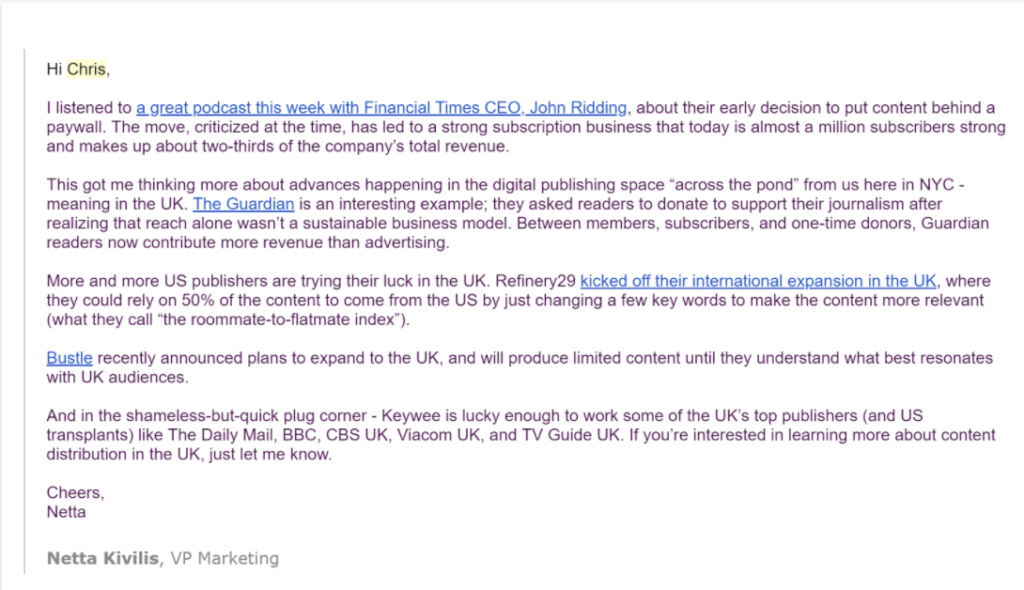In this post, I’m going to tell you all of the SECRET MARKETING TRICKS Blue Seedling pulls out of its magic hat to acquire new clients.
Trick #1: There are no secret marketing tricks. 🙁
Seriously though, we really don’t have any tricks, secret or not, nor do we have “silver bullets” that simply funnel clients to our doorstep, checkbook in hand. What we do have is our overarching marketing philosophy. In this post, I’ll share this philosophy and how it translates to marketing actions, and I’ll highlight marketing takeaways that are applicable to your startup. Obviously we’re different: Blue Seedling is a marketing agency, and you are a B2B startup. But there are parallels. Like your company, we’re small, we’re B2B, our resources are limited, but our ambition is not.
Blue Seedling’s Marketing Philosophy
At Blue Seedling, these are the three principles we live by—not only when working with clients, but when acquiring our own clients, as well. In other words, we definitely eat our own dog food.
1) You should know your target audience really well: who they are, where they “hang out” (physically and virtually), and what keeps them up at night.
2) You should have an excellent product that helps your audience with a pressing need.
3) You should market this product by creating informative, relevant, non-salesy content that creates value for your audience. (We mean “content” in the broad sense – events, emails, webinars are all content.)
4) Watch the “magic” happen.
OK, what does this actually mean though? How does Blue Seedling get its clients?
To date, all of our clients have come through three channels: referrals, content, and events. We have never done any advertising or paid marketing, online or offline. We’re not categorically opposed to paid marketing, but it’s expensive and time consuming, so for now, being a small company with limited resources, we avoid it. We also don’t believe it’s effective in B2B Enterprise marketing… more on that here.
Takeaway #1: You’re welcome to experiment with digital/paid marketing, but don’t be deterred if you don’t have the resources to do so. There are plenty of alternatives.
Want referrals? It starts with a good product… but doesn’t end there.
The vast majority of our clients came through a referral from another client or a partner (typically, a VC referring a portfolio company).
I’m a marketing person, so it’s easy for me to believe that good marketing and sales can sell any product. And to some extent, that’s true… but once the product is in the hands of the customer, a bad product will lead to an unhappy customer and zero referrals.
Takeaway #2: Referrals can be a significant driver of business… but don’t expect referrals if your customers don’t love your product.
That said, a great product is, as we say in computer science land, a necessary but insufficient condition. It’s rare that a good product sells itself. It’s also rare to get referrals without doing anything. You need to be top of mind — keep in touch, do customer marketing, meet in person, go to conferences, reach out on LinkedIn. In our case, this means that when someone needs a marketing agency, we want Blue Seedling to naturally come to mind.
Takeaway #3: Keep in touch. It’s totally fine to explicitly ask for referrals, and it’s even better to have touch points that will keep you top of mind to implicitly get referrals.
How Blue Seedling does content marketing
Well, you’re seeing it in action. 🙂
We love content marketing. We think it’s a channel that can be extremely effective, with high ROI, especially for small startups. What we don’t love is generic, “thought leadership” articles that are similar to dozens of other articles, and only live in the industry’s echo chamber, while your audience couldn’t care less.
What do we do instead? We keep honing our understanding of our target audience, their needs and pain points. Thus, we constantly get ideas for valuable content from listening to our clients. When two clients ask us the same question, or deal with the same challenge, we know it’s time for a blog post. That’s how most of our blog posts started, including Is my Cost per Lead too high?, Should I go to this conference?, and How to build a marketing budget.
Takeaway #4: Get ideas from your sales and customer success folks, who are in touch with customers all the time. Better yet, if you’re on the marketing team, make sure you’re in touch with customers, too. When I managed marketing folks they always had an OKR/goal related to customer contact, like “sit on two sales calls a month” or “meet at least one customer a quarter” or “go to one industry event.”
We distribute our content through simple text emails we send through Mailchimp (you can sign up at the bottom of this post!). Here’s an example:

These emails are sent to our entire database of leads from my own personal email address, and their average open rate is around 75%, with numerous replies — a small but consistent portion being leads interested in working together. It’s all authentic, even if it’s automated, and it works. People appreciate the email and engage quite enthusiastically. Oh, I also write like a human being.
Takeaway #5: It’s not about the tools. You don’t need a fancy marketing automation platform like Marketo and Hubspot for effective content and email marketing. It’s about knowing your audience and communicating with them authentically, in a format they appreciate, with content they care about.
It’s a marathon, not a sprint. The higher your ACV (Annual Contract Value) and the more Enterprise your sale, the longer your sales cycle is. That means closing a deal involves building a relationship and presenting multiple marketing touch points over a period of months or even years.
We were intro’d to the founders of one of our then-future clients by one of their investors. We gave plenty of marketing advice during our initial meeting, and followed up via email with a few related articles. Later that year, we invited them to one of our workshops. Unfortunately, they couldn’t attend. Shortly afterwards, they asked us if we knew anyone who could do a very small marketing task for them. We simply did it for them free of charge. Early the next year, they raised a round of funding, and were looking to invest in marketing. They became a client shortly thereafter. By then they knew us well, and didn’t feel the need to check out other agencies. We started working together almost a year and a half after the initial introduction.
Takeaway #6: If you’re in Enterprise sales, embrace the long marketing and sales cycle by having tools and processes to keep in touch and provide value— like your CRM, content (original and curated), and email. Events and meeting in person are the cherry on top.
Another tip: Easier said than done, but don’t be discouraged if the deal doesn’t ultimately happen. The goodwill you established will pay dividends down the road with introductions and recommendations. Play the long game and good things will happen.
Another idea for small startups: Partnerships + Events.
We love partnering with like-minded companies selling to our target audience but not competitive. Blue Seedling’s textbook example is partnering with a VC to offer a B2B marketing workshop for its portfolio companies. This is a win-win-win.
Takeaway #7: Who can you partner with in your space? Identify a few players and reach out, even cold on LinkedIn. Offer to collaborate on a webinar, prospect happy hour, or a content swap. There’s little to no direct $ investment, and you get exposure to new, relevant audience.
The Bottom Line
Any company — no matter its size or marketing budget — can do good marketing that leads to new customers. If you have a good product, understand your audience, and interact with that audience in an authentic, valuable way, you’re well on your way to impactful marketing.
Learn more
- Forget Google, LinkedIn, and Facebook: 7 channels to try instead
- How to hack content marketing as two Israeli developers
- Data Journalism: The best marketing channel you don’t know about
- The Best Marketing Calendar for Your Team: a Step-by-Step Guide
- The best source of content ideas is right in front of you
- It’s never about the tools: Why your marketing tech stack isn’t that important








